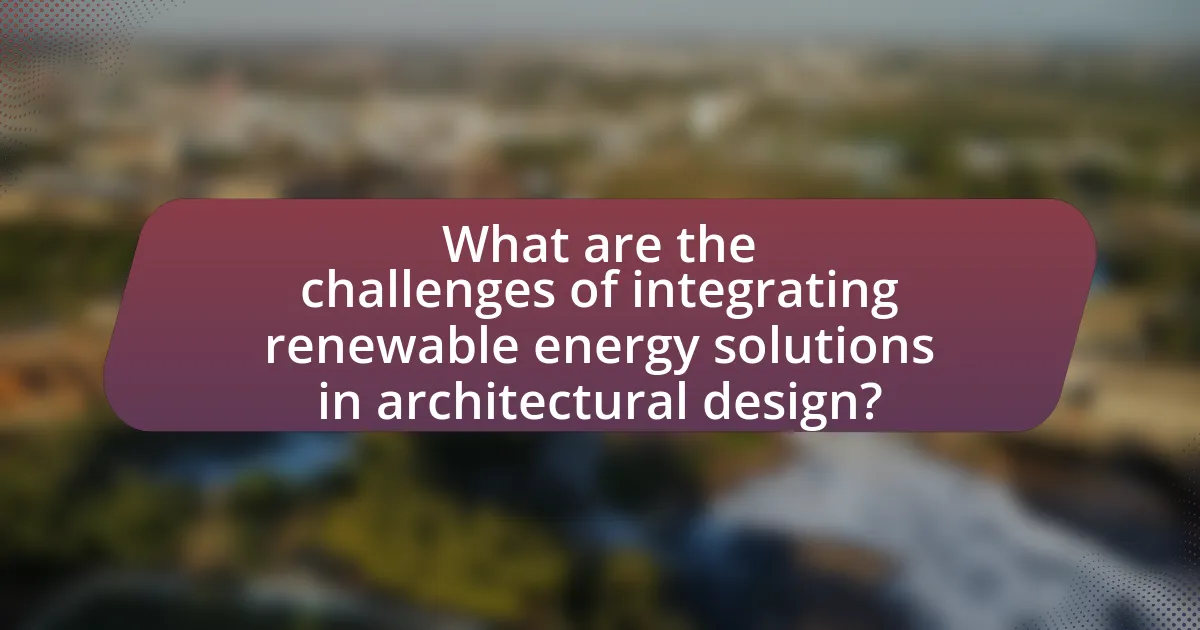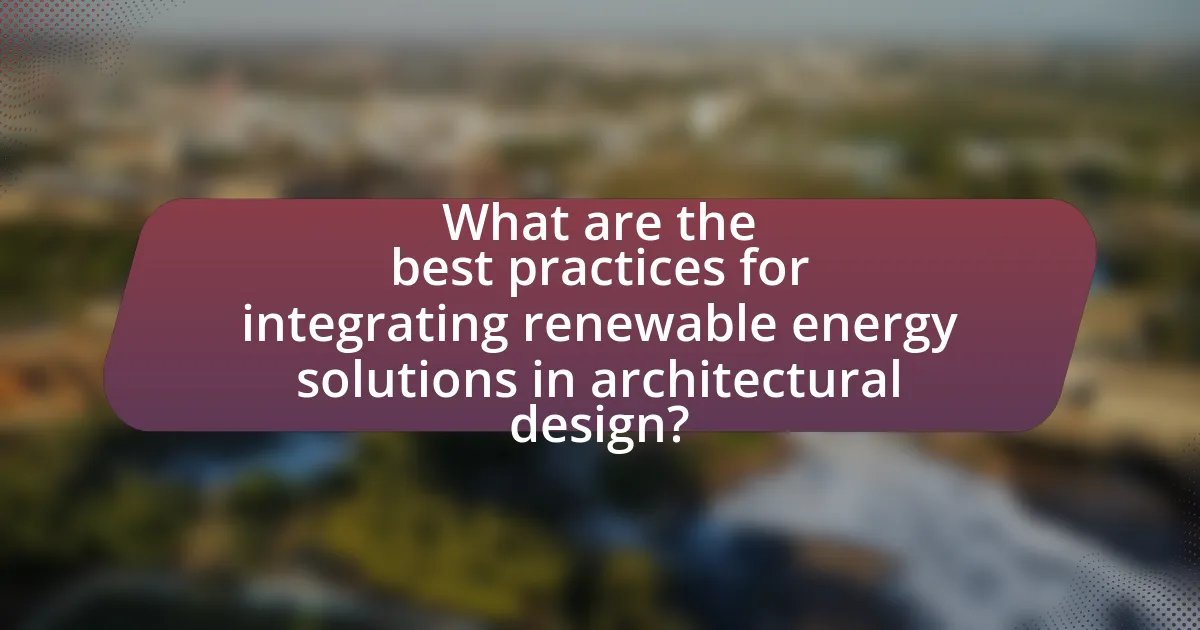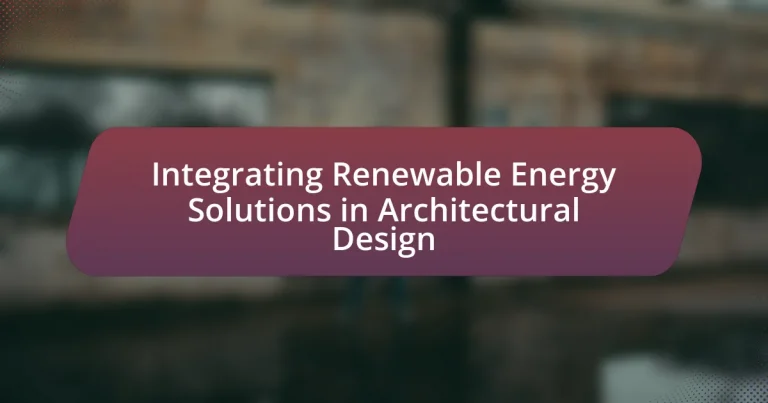Integrating renewable energy solutions in architectural design involves the incorporation of sustainable energy sources such as solar, wind, geothermal, and biomass into building structures to enhance energy efficiency and minimize environmental impact. This article explores how these solutions are integrated into architectural design, the types of renewable energy commonly used, and their significant benefits, including reduced greenhouse gas emissions and energy costs. It also addresses the challenges architects face in implementing these technologies, such as high initial costs and regulatory hurdles, while highlighting best practices for successful integration. Case studies exemplifying successful projects further illustrate the advantages of renewable energy solutions in architecture.

What are Renewable Energy Solutions in Architectural Design?
Renewable energy solutions in architectural design refer to the incorporation of sustainable energy sources, such as solar, wind, geothermal, and biomass, into building designs to enhance energy efficiency and reduce environmental impact. These solutions include solar panels for electricity generation, green roofs for insulation and rainwater management, and passive solar design techniques that optimize natural light and heat. According to the U.S. Department of Energy, buildings account for approximately 40% of total energy consumption, highlighting the importance of integrating renewable energy solutions to achieve energy efficiency and sustainability in architecture.
How do renewable energy solutions integrate into architectural design?
Renewable energy solutions integrate into architectural design by incorporating technologies such as solar panels, wind turbines, and geothermal systems directly into building structures. These technologies enhance energy efficiency and reduce reliance on fossil fuels, aligning with sustainable design principles. For instance, solar panels can be integrated into rooftops or facades, allowing buildings to generate their own electricity while maintaining aesthetic appeal. Additionally, passive solar design techniques, such as strategic window placement and thermal mass, optimize natural light and heat, further reducing energy consumption. Studies show that buildings designed with renewable energy solutions can achieve up to 50% energy savings compared to conventional designs, demonstrating their effectiveness in promoting sustainability in architecture.
What types of renewable energy solutions are commonly used in architecture?
Commonly used renewable energy solutions in architecture include solar energy, wind energy, geothermal energy, and biomass energy. Solar energy is harnessed through photovoltaic panels or solar thermal systems, providing electricity or heating. Wind energy is captured using turbines, which can be integrated into building designs to generate power. Geothermal energy utilizes the Earth’s internal heat for heating and cooling systems, enhancing energy efficiency. Biomass energy involves using organic materials for heating or electricity generation, contributing to sustainable practices in architecture. These solutions are increasingly adopted to reduce carbon footprints and enhance energy efficiency in buildings.
How do these solutions impact the overall design process?
Integrating renewable energy solutions significantly enhances the overall design process by promoting sustainability and efficiency in architectural projects. These solutions, such as solar panels and wind turbines, necessitate early-stage consideration in design, influencing layout, orientation, and material selection. For instance, incorporating solar energy systems can lead to optimized building orientation to maximize sunlight exposure, which in turn can reduce energy costs and improve environmental impact. Studies show that buildings designed with renewable energy solutions can achieve up to 30% greater energy efficiency compared to traditional designs, demonstrating their substantial effect on the design process.
Why is integrating renewable energy solutions important in architecture?
Integrating renewable energy solutions is important in architecture because it enhances sustainability and reduces environmental impact. By incorporating technologies such as solar panels, wind turbines, and geothermal systems, buildings can generate their own energy, leading to lower greenhouse gas emissions. According to the International Energy Agency, buildings account for approximately 36% of global energy use and 39% of energy-related carbon dioxide emissions. Therefore, utilizing renewable energy in architectural design not only promotes energy efficiency but also contributes to climate change mitigation and resource conservation.
What environmental benefits do renewable energy solutions provide?
Renewable energy solutions provide significant environmental benefits, primarily by reducing greenhouse gas emissions. For instance, transitioning from fossil fuels to renewable sources like solar and wind energy can decrease carbon dioxide emissions by up to 80% in the energy sector, as reported by the International Renewable Energy Agency (IRENA). Additionally, renewable energy reduces air pollution, which is linked to respiratory diseases and environmental degradation. According to a study by the National Renewable Energy Laboratory, the widespread adoption of renewable energy could prevent thousands of premature deaths annually due to improved air quality. Furthermore, renewable energy solutions promote biodiversity by minimizing habitat destruction associated with fossil fuel extraction and use. Overall, these benefits contribute to a more sustainable and healthier environment.
How do renewable energy solutions contribute to energy efficiency?
Renewable energy solutions enhance energy efficiency by providing sustainable power sources that reduce reliance on fossil fuels and lower overall energy consumption. For instance, solar panels convert sunlight into electricity, significantly decreasing the need for grid power, which is often generated from less efficient and more polluting sources. According to the U.S. Department of Energy, solar energy systems can reduce energy bills by 50% or more, demonstrating their effectiveness in improving energy efficiency. Additionally, integrating wind energy into architectural designs can optimize energy use by harnessing natural wind currents, further decreasing energy waste. This synergy between renewable energy technologies and energy efficiency leads to a more sustainable and cost-effective energy landscape.

What are the challenges of integrating renewable energy solutions in architectural design?
Integrating renewable energy solutions in architectural design faces several challenges, including high initial costs, technical complexity, and regulatory hurdles. High initial costs can deter architects and developers from adopting renewable technologies, as the upfront investment often exceeds traditional energy systems. Technical complexity arises from the need to seamlessly incorporate renewable systems, such as solar panels or wind turbines, into existing architectural frameworks without compromising aesthetics or functionality. Regulatory hurdles include navigating building codes and zoning laws that may not support innovative energy solutions, which can delay project timelines and increase costs. These challenges collectively hinder the widespread adoption of renewable energy in architectural design.
What technical obstacles do architects face when implementing these solutions?
Architects face several technical obstacles when implementing renewable energy solutions in architectural design, including integration complexity, regulatory challenges, and technological limitations. Integration complexity arises from the need to harmonize renewable energy systems, such as solar panels or wind turbines, with existing building structures and aesthetics, which can complicate design processes. Regulatory challenges often involve navigating local building codes and zoning laws that may not accommodate innovative energy solutions, leading to delays or additional costs. Technological limitations include the current inefficiencies of renewable energy technologies, such as energy storage systems that may not provide sufficient capacity or reliability for building needs, impacting overall feasibility. These obstacles can hinder the effective incorporation of renewable energy solutions into architectural projects.
How can architects overcome these technical challenges?
Architects can overcome technical challenges in integrating renewable energy solutions by employing advanced design software and simulation tools that optimize energy efficiency. These tools allow architects to analyze building performance, assess energy consumption, and evaluate the effectiveness of renewable technologies such as solar panels and wind turbines. For instance, the use of Building Information Modeling (BIM) can facilitate collaboration among stakeholders, ensuring that renewable energy systems are seamlessly integrated into the architectural design. Additionally, architects can stay updated on the latest materials and technologies, such as energy-efficient glazing and smart building systems, which enhance the overall sustainability of their designs.
What are the financial implications of integrating renewable energy solutions?
Integrating renewable energy solutions has significant financial implications, primarily involving initial investment costs, long-term savings, and potential revenue generation. The upfront costs for renewable energy systems, such as solar panels or wind turbines, can be substantial, often ranging from $15,000 to $30,000 for residential installations. However, these systems typically lead to reduced energy bills, with studies indicating savings of 50% or more on electricity costs over time. Additionally, renewable energy solutions can increase property values; homes with solar energy systems have been shown to sell for approximately 4% more than comparable homes without them. Furthermore, government incentives, such as tax credits and rebates, can offset initial costs, making the financial transition more feasible. Overall, while the initial investment is considerable, the long-term financial benefits and potential for increased property value present a compelling case for integrating renewable energy solutions in architectural design.
How do regulations and standards affect the integration of renewable energy solutions?
Regulations and standards significantly influence the integration of renewable energy solutions by establishing the legal framework and technical requirements that govern their implementation. These regulations ensure safety, reliability, and environmental protection, which are essential for gaining public and investor confidence. For instance, building codes may mandate specific energy efficiency standards, while interconnection standards dictate how renewable energy systems connect to the grid. Compliance with these regulations can facilitate smoother project approvals and access to incentives, such as tax credits or grants, which can enhance the financial viability of renewable energy projects. Furthermore, adherence to international standards, like those set by the International Organization for Standardization (ISO), can promote best practices and innovation in renewable energy technologies, ultimately accelerating their adoption in architectural design.
What are the key regulations architects must consider?
Architects must consider building codes, zoning laws, environmental regulations, and energy efficiency standards. Building codes ensure structural integrity and safety, while zoning laws dictate land use and building placement. Environmental regulations, such as the Clean Air Act and Clean Water Act, govern the impact of construction on natural resources. Energy efficiency standards, including those set by the International Energy Conservation Code, promote the integration of renewable energy solutions in architectural design, ensuring that buildings meet sustainability goals.
How do building codes influence the adoption of renewable energy technologies?
Building codes significantly influence the adoption of renewable energy technologies by establishing minimum standards that encourage or mandate their integration into new constructions. These codes can include requirements for energy efficiency, renewable energy systems, and sustainable materials, which directly impact the feasibility and attractiveness of implementing technologies such as solar panels, wind turbines, and energy-efficient HVAC systems. For instance, the International Energy Conservation Code (IECC) sets guidelines that promote energy-efficient building practices, leading to increased adoption of renewable technologies. Additionally, local jurisdictions may offer incentives or streamlined permitting processes for buildings that comply with advanced energy codes, further driving the integration of renewable energy solutions in architectural design.

What are the best practices for integrating renewable energy solutions in architectural design?
The best practices for integrating renewable energy solutions in architectural design include optimizing building orientation, utilizing energy-efficient materials, and incorporating renewable energy technologies such as solar panels and wind turbines. Optimizing building orientation maximizes natural light and reduces energy consumption, as evidenced by studies showing that south-facing windows can increase passive solar heating by up to 30%. Using energy-efficient materials, such as high-performance insulation and low-emissivity windows, enhances thermal performance and reduces reliance on heating and cooling systems. Additionally, incorporating renewable energy technologies not only decreases carbon footprints but can also lead to significant cost savings; for instance, buildings equipped with solar panels can reduce energy bills by 50% or more, according to the U.S. Department of Energy.
How can architects effectively plan for renewable energy integration?
Architects can effectively plan for renewable energy integration by conducting thorough site assessments and utilizing energy modeling tools. Site assessments help identify optimal locations for solar panels, wind turbines, and other renewable technologies based on factors such as sunlight exposure, wind patterns, and local climate conditions. Energy modeling tools allow architects to simulate energy consumption and production, enabling them to design buildings that maximize energy efficiency and renewable energy use. According to the U.S. Department of Energy, buildings designed with integrated renewable energy systems can reduce energy costs by up to 50%, demonstrating the financial and environmental benefits of such planning.
What design strategies enhance the effectiveness of renewable energy solutions?
Design strategies that enhance the effectiveness of renewable energy solutions include optimizing building orientation, utilizing passive solar design, and incorporating energy-efficient materials. Optimizing building orientation maximizes solar gain and minimizes energy loss, which is crucial for solar energy systems. Passive solar design techniques, such as strategic window placement and thermal mass, help regulate indoor temperatures, reducing reliance on mechanical heating and cooling. Additionally, using energy-efficient materials, such as high-performance insulation and low-emissivity windows, significantly lowers energy consumption. Research indicates that buildings designed with these strategies can achieve energy savings of up to 50% compared to conventional designs, demonstrating their effectiveness in integrating renewable energy solutions.
How can collaboration with engineers improve renewable energy integration?
Collaboration with engineers can significantly enhance renewable energy integration by leveraging their technical expertise to optimize system design and implementation. Engineers apply their knowledge of energy systems, materials, and technologies to create efficient designs that maximize energy output and minimize waste. For instance, a study by the National Renewable Energy Laboratory found that interdisciplinary collaboration can lead to a 20% increase in energy efficiency in building designs that incorporate renewable technologies. This collaboration ensures that renewable energy systems, such as solar panels and wind turbines, are effectively integrated into architectural designs, resulting in sustainable and functional buildings.
What case studies exemplify successful integration of renewable energy in architecture?
The Bosco Verticale in Milan, Italy, exemplifies successful integration of renewable energy in architecture by incorporating vertical gardens that enhance energy efficiency and biodiversity. This residential complex features over 9,000 trees and 20,000 plants, which contribute to natural insulation, reducing energy consumption for heating and cooling. Additionally, the building’s design promotes natural ventilation and utilizes solar panels to generate renewable energy, demonstrating a holistic approach to sustainable architecture. Another notable case is the Bullitt Center in Seattle, which is designed to be net-zero energy, utilizing solar panels and rainwater harvesting systems to achieve its sustainability goals. The center’s energy-efficient design and renewable energy systems have made it a model for green building practices.
What lessons can be learned from these successful projects?
Successful projects in integrating renewable energy solutions in architectural design demonstrate the importance of early planning and collaboration among stakeholders. These projects highlight that involving architects, engineers, and energy consultants from the outset leads to innovative designs that maximize energy efficiency. For instance, the Bullitt Center in Seattle, often referred to as the greenest commercial building in the world, showcases how a holistic approach to design can achieve net-zero energy consumption through solar panels and rainwater harvesting. This project exemplifies that prioritizing sustainability in the design phase can result in significant long-term cost savings and environmental benefits.
How do these case studies demonstrate the benefits of renewable energy solutions?
Case studies demonstrate the benefits of renewable energy solutions by showcasing significant reductions in energy costs and environmental impact. For instance, a case study on a solar-powered building revealed a 40% decrease in annual energy expenses compared to traditional energy sources. Additionally, these case studies highlight the reduction of carbon emissions, with one project reporting a decrease of 30 tons of CO2 emissions annually due to the implementation of wind energy systems. Such evidence underscores the economic and ecological advantages of integrating renewable energy into architectural design.
What practical tips can architects follow for successful integration of renewable energy solutions?
Architects can successfully integrate renewable energy solutions by prioritizing site analysis, optimizing building orientation, and selecting appropriate technologies. Conducting a thorough site analysis allows architects to understand local climate conditions, which is crucial for maximizing solar gain and wind energy potential. Optimizing building orientation, such as positioning windows and solar panels to capture sunlight effectively, enhances energy efficiency. Additionally, selecting technologies like photovoltaic systems, solar thermal systems, and geothermal heating can provide sustainable energy sources tailored to the building’s needs. According to the U.S. Department of Energy, buildings designed with these considerations can reduce energy consumption by up to 50%.





